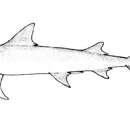Diagnostic Description
provided by Fishbase
A slender weasel shark with a long, broadly rounded snout, large curved, saw-edged teeth in the upper jaw, and hooked lower teeth protruding from mouth; gill slits long; fins strongly curved (Ref. 5578). Light grey or bronzy with no prominent markings (Ref. 5578).
- Recorder
- Cristina V. Garilao
Life Cycle
provided by Fishbase
Viviparous, with 2 to 11 young in a litter (Ref. 6871) after a gestation period of 7-8 months; possibly reproduces in alternate years (Ref.58048). Size at birth about 45-52 cm TL (Ref. 13567, Ref.58048). Distinct pairing with embrace (Ref. 205).
- Recorder
- Cristina V. Garilao
Morphology
provided by Fishbase
Dorsal spines (total): 0; Dorsal soft rays (total): 0; Analspines: 0; Analsoft rays: 0
- Recorder
- Cristina V. Garilao
Trophic Strategy
provided by Fishbase
Occurs on the continental shelf (Ref. 75154).
Biology
provided by Fishbase
A coastal species, found inshore and offshore on the continental and insular shelves (Ref. 244). Feeds on sharks, rays and bony fishes (Ref. 244); also cephalopods (Ref. 13567). Viviparous (Ref. 50449). Thought to be potentially dangerous because of its large, fearsome teeth and shallow-water habitat, but has not been recorded in an attack on people (Ref. 244). Caught regularly by inshore gillnet, bottom trawl (occasionally) and longline fisheries (Ref.58048). Regularly taken in artisanal fisheries (Ref. 13567). Utilized fresh for human consumption, liver processed for vitamins, fins used in the oriental shark fin trade, and by-products processed into fishmeal (Ref. 244). Most adults below 200 cm (Ref. 30573).
- Recorder
- Kent E. Carpenter
Importance
provided by Fishbase
fisheries: commercial
- Recorder
- Kent E. Carpenter
分布
provided by The Fish Database of Taiwan
廣泛分布在印度-西太平洋熱帶,包含紅海,西南非、南澳洲。
利用
provided by The Fish Database of Taiwan
主要以底拖網或延繩釣捕獲。肉質不佳,一般皆以下雜魚處理。
描述
provided by The Fish Database of Taiwan
身體呈紡錘形,吻部圓鈍且寬廣。眼睛一般大;鰓裂長。上排牙齒的邊緣粗糙呈鋸齒狀,側邊彎曲近三角形(狹窄靠近牙齦);下排牙齒長且彎曲,呈錐形,靠近牙齦,在基部有時會發展成鋸齒狀;後部鋸齒的形狀與上部相似。第一背鰭點超過或剛好超過胸鰭尖端;第二背鰭起點在臀鰭起點之前。魚鰭呈鐮刀狀,第二背鰭、臀鰭、腹鰭及胸鰭邊緣具有明顯凹陷。上排牙齒26-28顆,下排33-36顆。總脊椎骨數190-195;尾前脊椎骨數104-107。背部體色成青銅色至灰棕色,腹部灰白色;第二背鰭及尾鰭上部有黑色斑。(陳柔蓉、林沛立2012/11編寫)
棲地
provided by The Fish Database of Taiwan
生活在狹窄的大陸棚到深度130公尺。
Snaggletooth shark
provided by wikipedia EN
The snaggletooth shark, or fossil shark (Hemipristis elongata), is a species of weasel shark in the family Hemigaleidae, and the only extant member of the genus Hemipristis. It is found in the Indo-West Pacific, including the Red Sea, from southeast Africa to the Philippines, north to China, and south to Australia, at depths from 1 to 130 meters. This shark can be found near the bottom of the water column of coastal areas, but can be found at continental and insular shelves.[1] Its length is up to 240 cm (7.87 ft) .[2] Despite being only vulnerable to extinction, this shark is very rarely seen.
Anatomy
The snaggletooth's coloration is light grey or bronze with no prominent markings. As its name suggests, it has sharp, serrated teeth on the upper jaw and hooked teeth on the bottom jaw. The shape of its body is fusiform, allowing it greater speed in the water.[3]
Reproduction is a special kind of viviparity, called placental viviparity, where the shark carries its live young in a placenta-like structure, complete with umbilical cord. The structure is derived from the wall of the embryonic yolk sac that has fused with the uterine wall.[4]
Food
The snaggletooth shark preys on a variety of different animals, including bony fish, other sharks, rays, crabs, and cephalopods.[5][3][6]
Commercial uses
This shark is usually caught by fishing trawlers (a type of fishing boat), or by gill nets. Fins are used in the shark fin soup trade in China and other Asian countries. The meat is sold for consumption, the liver is used as a source for vitamins and the rest of the carcass is processed into fish meal.[2]
References
-
^ "Hemipristis elongatus (Klunzinger, 1871) Snaggletooth shark". Fishbase. Retrieved 9 November 2011.
-
^ a b Katkar, B.N. and C. J. Josekutty (2003). "Snaggletooth shark, Hemipristis elongata landed at Sassoon Dock, Mumbai" (PDF). Mar. Fish. Infor. Serv. 176: 12.
-
^ a b Manojkumar, P.P and P.P. Pavithran. (2004). "First record of snaggletooth shark, Hemipristis elongata (Klumzinger, 1871) from Malabar Coast" (PDF). Mar. Fish. Infor. Serv. 180: 13–14.
-
^ Cech, Moyle, Joseph J. Jr., Peter B (2004). Fishes: An Introduction to Ichthyology. Upper Saddle River: Prentice Hall. p. 15. ISBN 0-13-100847-1.
-
^ "Hemipristis elongatus (Klunzinger, 1871) Snaggletooth shark". Fishbase. Retrieved 9 November 2011.
-
^ Chandrasekar, S. and P. Devadoss (1991). "A note on the rare snaggle tooth shark, Hemipristis elongata" (PDF). Mar. Fish. Infor. Serv. 114: 36.

- license
- cc-by-sa-3.0
- copyright
- Wikipedia authors and editors
Snaggletooth shark: Brief Summary
provided by wikipedia EN
The snaggletooth shark, or fossil shark (Hemipristis elongata), is a species of weasel shark in the family Hemigaleidae, and the only extant member of the genus Hemipristis. It is found in the Indo-West Pacific, including the Red Sea, from southeast Africa to the Philippines, north to China, and south to Australia, at depths from 1 to 130 meters. This shark can be found near the bottom of the water column of coastal areas, but can be found at continental and insular shelves. Its length is up to 240 cm (7.87 ft) . Despite being only vulnerable to extinction, this shark is very rarely seen.
- license
- cc-by-sa-3.0
- copyright
- Wikipedia authors and editors

